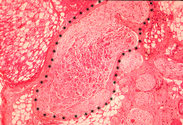 Identify the tissue as indicated by the black dots:
Identify the tissue as indicated by the black dots:
Question 1 - Single Best Answer
 Identify the tissue as indicated by the black dots:
Identify the tissue as indicated by the black dots:
A) myelinated nerve fiber
B) smooth muscle
C) spiral ganglion
D) sympathetic ganglion
E) unmyelinated nerve fiber
Question 2 - Single Best Answer
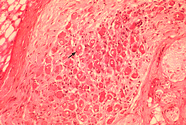 Identify the cell at the tip of the arrow:
Identify the cell at the tip of the arrow:
A) fibroblast
B) satellite cell
C) Schwann cell
D) ganglion cell
E) endothelial cell
Question 3 - Single Best Answer
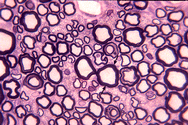 Identify the structure at the tip of the arrow:
Identify the structure at the tip of the arrow:
A) unmyelinated nerve fiber
B) smooth muscle cell
C) myelinated nerve fiber
D) ganglion cell
E) adipocyte
Question 4 - Single Best Answer
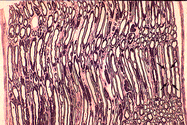 Identify the structure at the tip of the arrow:
Identify the structure at the tip of the arrow:
A) Schmidt-Lantermann cleft
B) axon
C) epineurium
D) node of Ranvier
E) perineurium
Question 5 - Single Best Answer
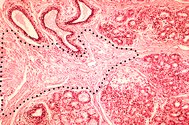 Identify the tissue surrounded by the dotted lines:
Identify the tissue surrounded by the dotted lines:
A) fibrocartilage
B) smooth muscle
C) dense regular connective tissue
D) dense irregular connective tissue
E) myelinated nerve
Question 6 - Single Best Answer
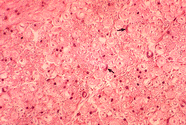 Identify the cell at the tip of the arrow:
Identify the cell at the tip of the arrow:
A) Schwann cell
B) endothelial cell
C) satellite cell
D) fibroblast
E) axon
Question 7 - Single Best Answer
A) unmyelinated nerve fiber
B) Pacinian corpuscle
C) myelinated nerve
D) adipose tissue
E) Meissner's corpuscle
Question 8 - Single Best Answer
 Identify the structure at the tip of the arrow:
Identify the structure at the tip of the arrow:
A) node of Ranvier
B) endoneurium
C) myelin sheath
D) perineurium
E) epineurium
Question 9 - Single Best Answer
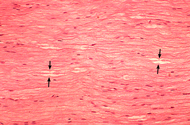 Identify the structure at the tip of the arrow:
Identify the structure at the tip of the arrow:
A) axon
B) perineurium
C) epineurium
D) Schmidt-Lantermann cleft
E) node of Ranvier
Question 10 - Single Best Answer
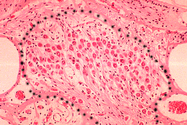 Identify the tissue as indicated by black dots:
Identify the tissue as indicated by black dots:
A) sympathetic ganglion
B) spiral ganglion
C) unmyelinated nerve fiber
D) myelinated nerve fiber
E) smooth muscle
Question 11 - Single Best Answer
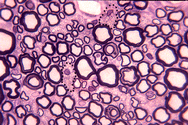 Identify the tissue as indicated by dots:
Identify the tissue as indicated by dots:
A) smooth muscle
B) loose connective tissue
C) unmyelinated nerve fiber
D) myelinated nerve fiber
E) adipocyte
Question 12 - Single Best Answer
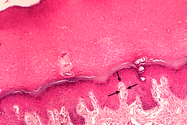 Identify the structure at the tip of the arrow:
Identify the structure at the tip of the arrow:
A) adipose tissue
B) Pacinian corpuscle
C) unmyelinated nerve fiber
D) Meissner's corpuscle
E) myelinated nerve
Question 13 - Single Best Answer
Bobby is an 8 year old white male with bilateral hearing loss and unsteadiness. He also has flat, segmented sesions on his skin (known as cafe-au-lait spots because they resemble coffee with milk). He is given a diagnosis of vonRecklinghausen's disease. This is an autosomal dominant disorder that is characterized by overgrowth of Schwann cells (from cranial nerve 8 and others in this case. Because of this, the lesion may also be called an acoustic neurilemmoma or acoustic schwannoma). Which limb of the nervous system is involved with this disease?
A) central nervous system
B) peripheral nervous system
C) autonomic nervous system
D) visceral nervous system
Question 14 - Single Best Answer
Identify the Schwann cell.
A)
B)
C)
D)
Question 15 - Single Best Answer
Which portion of the neuron is injured by the overgrowth of schwann cells?
A) dendrites
B) neuromuscular junction
C) axon
D) cell body
Question 16 - Single Best Answer
Classify the type of neuron the pathologist would see upon removal of the lesion causing the symptoms above.
A) bipolar
B) unipolar
C) pseudopolar